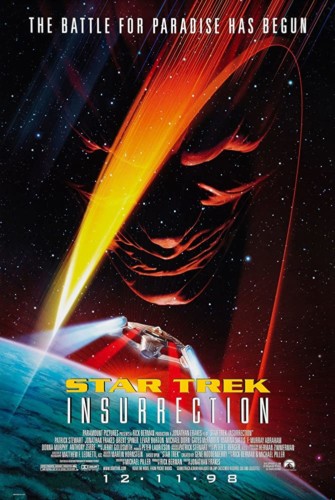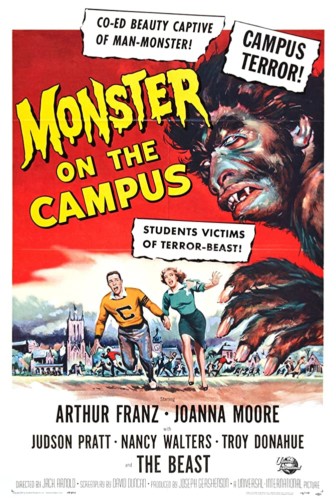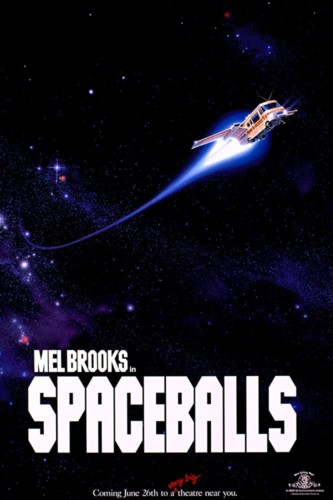 Star Trek: Insurrection (1998) – And now we’ve gone back to mining old episodes for under-explored ideas (or maybe just story concepts that they hope we won’t remember having seen before). In this case, take the premise of the 7th season “Journey’s End,” in which Picard is tasked with moving a colony of Native Americans for diplomatic reasons… but this time, put Picard in full “tired of this crap” mode.
Star Trek: Insurrection (1998) – And now we’ve gone back to mining old episodes for under-explored ideas (or maybe just story concepts that they hope we won’t remember having seen before). In this case, take the premise of the 7th season “Journey’s End,” in which Picard is tasked with moving a colony of Native Americans for diplomatic reasons… but this time, put Picard in full “tired of this crap” mode.
And then, in a twist, let’s just imagine that the 6th season episode “Rascals,” in which the crew accidentally discovers the Fountain of Youth and works hard to reverse it, never happened, because this time out they’ve discovered another Fountain of Youth, and it’s really really important.
This movie shows how much the character of Star Trek had changed since the original series. Kirk and company encountered and clashed with “stagnant” cultures and civilizations at least three times (and that was a subplot at least three other times). Back then, ideas of progress and advancement were the ultimate ideal. Now, the intentionally non-technological agrarian society of the Ba’Ku (complete with that incredibly idealized picture of farm life that can only come from an urbanized mind) is shown as the path to fulfillment.
 Monster on the Campus (1958) – Let’s get one thing straight here: There is no “force of evolution” that certain organisms like the coelacanth could mysteriously and uniquely “resist.” Coelacanths, horseshoe crabs, and other “living fossils” have stayed pretty much the same for millions of years simply because there has been no reason to change; there has been no environmental factor that makes a variation to the “standard” genetic pattern more viable or able to survive. Yes, it’s a movie about a scientist who accidentally regresses to an ape-man because of gamma-irradiated coelacanth bodily fluids and terrorizes the campus, and that’s my sticking point.
Monster on the Campus (1958) – Let’s get one thing straight here: There is no “force of evolution” that certain organisms like the coelacanth could mysteriously and uniquely “resist.” Coelacanths, horseshoe crabs, and other “living fossils” have stayed pretty much the same for millions of years simply because there has been no reason to change; there has been no environmental factor that makes a variation to the “standard” genetic pattern more viable or able to survive. Yes, it’s a movie about a scientist who accidentally regresses to an ape-man because of gamma-irradiated coelacanth bodily fluids and terrorizes the campus, and that’s my sticking point.
Actually, given that this was a low-budget effort a full decade before Planet of the Apes, the full-face ape-man appliance is surprisingly good.
Also, Chrome’s built-in spellchecker doesn’t recognize “coelacanth.”
 Spaceballs (1987) – Hadn’t seen this in at least twenty-five years. The humor is pretty much all sophomoric and obvious. And then my sixteen-year-old daughter wandered in and laughed. And kept laughing. And said, “These jokes are so bad,” but kept laughing and kept watching. And suddenly I felt very, very old. “Sophomoric” isn’t a pejorative, it’s an accurate description of the target demographic.
Spaceballs (1987) – Hadn’t seen this in at least twenty-five years. The humor is pretty much all sophomoric and obvious. And then my sixteen-year-old daughter wandered in and laughed. And kept laughing. And said, “These jokes are so bad,” but kept laughing and kept watching. And suddenly I felt very, very old. “Sophomoric” isn’t a pejorative, it’s an accurate description of the target demographic.
Abandoned movies:
Terrordactyl (2016) – After the pre-credits “random nobody gets munched by monster” scene, we get some character scenes… and more character scenes… and MORE… and I started to suspect that maybe the filmmakers forgot they were making a monster movie.
The Aftermath (1982) – Imagine the first ten minutes of Planet of the Apes, but they couldn’t afford either caveman or ape costumes, so instead they dressed everyone off the Goodwill rack. Also, imagine Charlton Heston was replaced with a random extra.
And then, in a twist, let’s just imagine that the 6th season episode “Rascals,” in which the crew accidentally discovers the Fountain of Youth and works hard to reverse it, never happened,
To be fair, I think most of the fans imagine that “Rascals” never happened.
Though come to think of it, they also used the transporter to reverse aging in “Unnatural Selection” (granted, artificially induced aging, but I can’t think of any reason that the same technique wouldn’t work for natural aging, injury, or disease as well). I could swear there were also a bunch of other miracle cures used in one episode and then forgotten.
The curse of episodic TV. (The original series did it too, of course — everything from easy time travel to instant psychokinetic powers.)
Heh. Called it!
Seriously, though, “Rascals” was only half bad as episodes go; and the bad half was the implausible Ferengi takeover, not the Fountain of Youth part. Star Trek movies would have been a lot better if they’d used their big budgets to follow up on things like that from the TV episodes instead of ignoring them and pretending they never happened. Of course, if they did that with some things, like the “rejuvenatory transportation” discovered in that “Rascals” episode, that might lead to a lot of plot-breaking problems, sort of like when How It Should Have Ended put those super-long-range transporters and the death-curing “super blood” from Star Trek: Into Darkness to good use.
Let’s just say that “Rascals” was both-halves bad, but for different reasons: The rejuvenation was bad because it opened a huge society-changing kettle of worms that no one wanted to deal with so they ignored it, and the Ferengi plot was bad because it was the most embarrassing alien encounter since Pakleds came along.